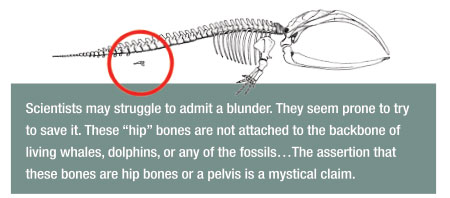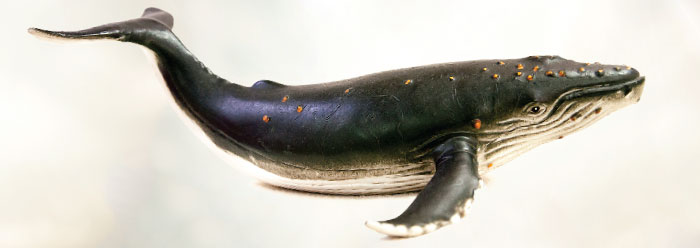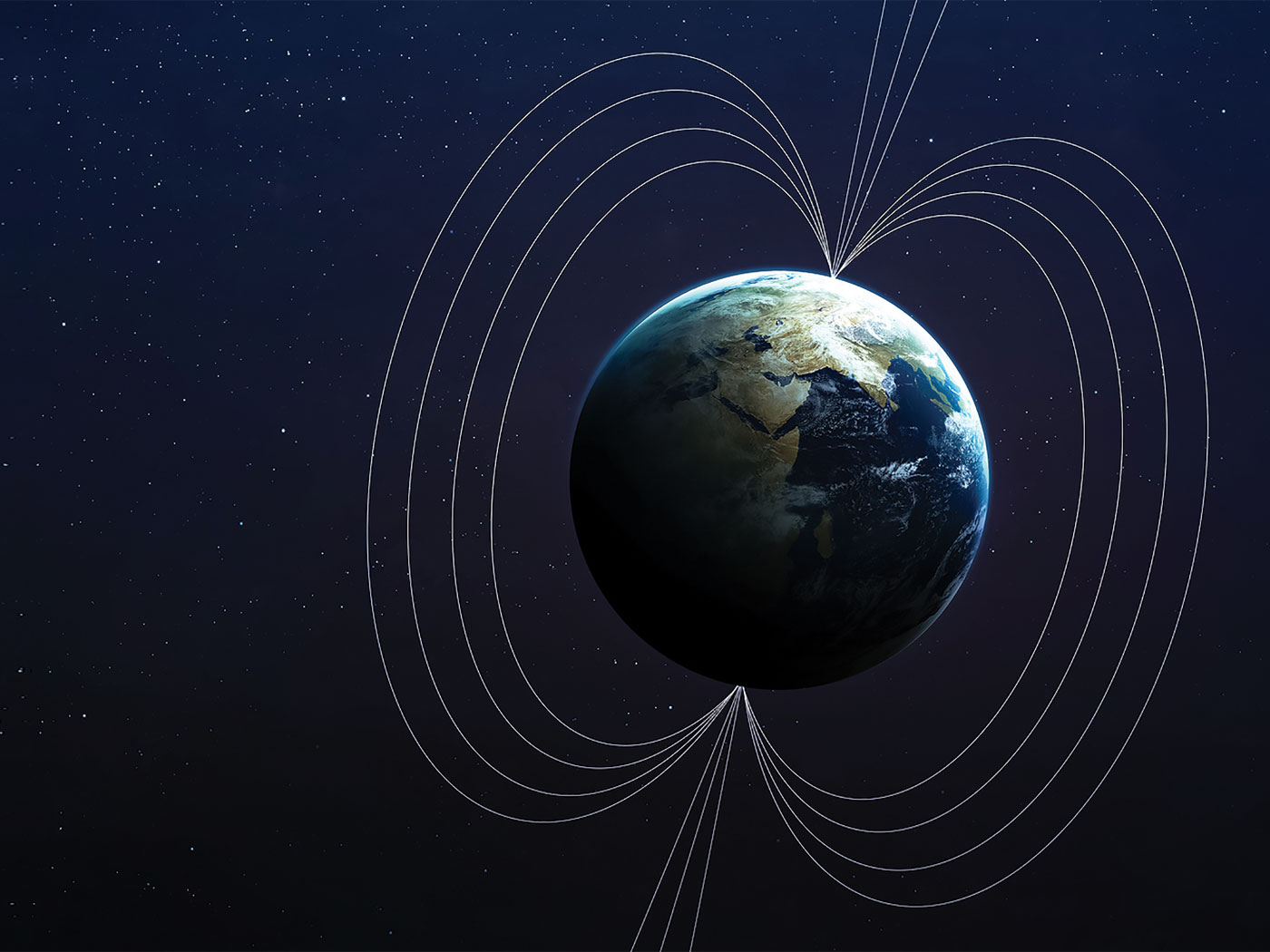National Geographic has a Little Kids First Big Book of… series on different topics. In its Little Kids First Big Book of Animals, pictures show giraffes, camels, bears, and whales.1 Young readers can see they all look different. Animals that live on land, like bears, have legs. But no one has seen a whale with legs. However, upon closer look, bears and whales do have some of the same traits. They both give birth to live young and nurse their offspring. Some whales also have hair in particular places on their body. These similar traits mean that both bears and whales are mammals. Some land mammals swim in the water a lot. What would happen if one type started to live more in the water than on land? Would its front legs slowly change to flippers like a whale has? Would its back legs gradually disappear? Is it possible that over a long time one kind of land animal could even become a whale?
The Evolutionary Origin of Whales
Some evolutionists used to imagine that whales could evolve from an animal like a bear. Charles Darwin considered how black bears can swim for a long time. Once he wrote about such bears
…swimming for hours with widely open mouth, thus catching, like a whale, insects in the water. Even in so extreme a case as this, if the supply of insects were constant, and if better adapted competitors did not already exist in the country, I can see no difficulty in a race of bears being rendered, by natural selection, more and more aquatic in their structure and habits, with larger and larger mouths, till a creature was produced as monstrous as a whale.2
This scenario flows from a very fertile imagination. But, as documented in an earlier article, imaginary extrapolation is a key element of evolutionary theory.3
Darwin’s thought about a bear-like animal evolving into whales is now seen more as an illustration than a reality. For many years, evolutionists held that whales evolved from an extinct carnivorous mammal group called mesonychids. Their interpretation of fossils supported their conclusion. Ernst Mayr said in 2001, “A beautiful series of intermediate stages also exists between the mesonychid ungulates and their descendants, the whales.”4
But now most evolutionists reject the mesonychids as ancestors for whales. Instead, important new fossils discovered in Pakistan are interpreted as filling that role. DNA sequences have also been compared between whales and living animals that have features similar to those of the new fossils. Evolutionists now have “a firm understanding” that whales evolved from an animal more related to giraffes and camels.5 Unfortunately, “substantial discrepancies remain” between interpretations of fossil data and results from DNA studies, according to Johns Hopkins University professor Kenneth Rose.6 Rose and others explain that similarities between whales and mesonychids happened independently in both groups due to “convergent evolution.” Convergence is not an observation flowing from objectively discernable causes. It is actually a declaration based on mental pictures of diverse organisms evolving similar traits as they are shaped over time by similar environmental pressures—which themselves are not real, quantifiable pressures but exist only as figures of speech.
There are still substantial discrepancies between DNA and fossil evidence for whale evolution. But evolutionists remain convinced “the transition from a primitively quadrupedal terrestrial ancestor to a convergently ‘fish-like’ modern mammal species” actually happened in a process that “involved changes in numerous character systems.” Definitely not understating the point, they add that “almost all anatomical systems of living cetaceans are highly modified for an aquatic lifestyle, with dramatic changes seen in…limbs.”7
Whale Hip Bones as Evidence for Whale Evolution
Speaking of limbs, evolutionists believe they see greatly reduced pelvis or hip bones in some whales. They teach this observation as hard evidence for whale evolution. Just like the human appendix,8 these “hip” bones are interpreted as a vestigial structure. Jerry Coyne from the University of Chicago sums up the evolutionary position nicely:
Whales are treasure troves of vestigial organs. Many living species have a vestigial pelvis and leg bones, testifying…to their descent from four-legged ancestors. If you look at a complete whale skeleton in a museum, you’ll often see the tiny hindlimb and pelvic bones hanging from the rest of the skeleton, suspended by wires. That’s because in living whales they’re not connected to the rest of the bones, but are simply imbedded in tissue. They once were part of the skeleton, but became disconnected and tiny when they were no longer needed.9
For decades, evolutionists did not search for any other uses for these bones. Why? Because a vestigial pelvis was what they expected to find.
Declarations About Whale Hip Bones Were Wrong
Fortunately, two researchers were not fully content with the customary explanation. In light of their research, the standard evolutionary story about whale hip bones, as relayed by Coyne, appears to be another major evolutionary blunder.
Matthew Dean of the University of Southern California and Jim Dines of the Natural History Museum of Los Angeles County examined “hip” bones in whale and dolphin skeletons. Their painstaking research of more than 10,000 unsorted bones turned “a long-accepted evolutionary assumption on its head.” According to the report, “common wisdom has long held that those bones are simply vestigial, slowly withering away like tailbones on humans.” But their results “[fly] directly in the face of that assumption, finding that not only do those pelvic bones serve a purpose—but their size and possibly shape are influenced by the forces of sexual selection.”10 This new analysis of whale hips was published in the scientific journal Evolution.11
Dines and Dean are evolutionists. They still believe that whales evolved from a four-legged land mammal. Thus, they believe that they really are studying vestigial hip bones. But, as reported, “‘everyone’s always assumed that if you gave whales and dolphins a few more million years of evolution, the pelvic bones would disappear. But it appears that’s not the case,’ said Matthew Dean.”10
These bones serve an important purpose. In fact, “the muscles that control a cetacean’s penis—which has a high degree of mobility—attach directly to its pelvic bones. As such, it made sense to Dean and Dines that the pelvic bones could affect the level of control over the penis that an individual cetacean has, perhaps offering an evolutionary advantage.”10
Dean and Dines are not likely to say that their research highlighted another evolutionary blunder over beliefs about vestigial organs. But Dean did admit that “our research really changes the way we think about the evolution of whale pelvic bones in particular, but more generally about structures we call ‘vestigial.’ As a parallel, we are now learning that our appendix is actually quite important in several immune processes, not a functionally useless structure.”10
Salvaging the Darwinian Whale Hip Story
Scientists may struggle to admit a blunder. They seem prone to try to save it. These “hip” bones are not attached to the backbone of living whales, dolphins, or any of the fossils. Claims beyond the realm of human detection are mystical. The assertion that these bones are hip bones or a pelvis is a mystical claim. Thus, Coyne’s defense that whale “hip” bones are truly vestigial remnants invokes mysticism.
 Salvage efforts may force even more mystical appeals. Coyne acknowledges that whales use the bones during reproduction. But as to the conclusion that the bones are not vestigial, he adds, “This argument is wrong: no evolutionist denies that the remnants of ancestral traits can retain some functionality or be co-opted for other uses.”12 For evolutionists, reproductive functions are simply “co-opted” from a locomotive function. Co-option is not an observation, it is a declaration. When does a researcher observe co-option happening? If one takes a moment to think about it, what part on a human doesn’t have more than one function? Co-option is summoned to fit ill-fitting findings into evolutionary theory.
Salvage efforts may force even more mystical appeals. Coyne acknowledges that whales use the bones during reproduction. But as to the conclusion that the bones are not vestigial, he adds, “This argument is wrong: no evolutionist denies that the remnants of ancestral traits can retain some functionality or be co-opted for other uses.”12 For evolutionists, reproductive functions are simply “co-opted” from a locomotive function. Co-option is not an observation, it is a declaration. When does a researcher observe co-option happening? If one takes a moment to think about it, what part on a human doesn’t have more than one function? Co-option is summoned to fit ill-fitting findings into evolutionary theory.
Evolutionists also try to work some fossil evidence into their land mammal-to-water mammal evolutionary scenario. Included are fossils discovered in Southwest Asia of four-legged creatures with a true pelvis. They have essentially no resemblance to whales. However, the evolutionary community embraced research that asserted they were a primitive type of whale. Whales and dolphins are categorized as cetaceans. These fossil creatures were given names like Ambulocetus and Pakicetus, which place them in the same category. But how does one know that these are truly fossils of the evolutionary ancestor of whales? Obtaining convincing proof of that is difficult. Changing the definition of what constitutes a whale is easier.
An article titled “What Is a Whale?” in Science dealt with the issue of deciding whether Ambulocetus was in the whale’s lineage. It reasonably noted, “Another problem arises considering that discoveries of ostensible whales occur fairly regularly…with new combinations of characters making it difficult to decide whether they are whales following a strictly character-based definition.” In other words, shouldn’t a creature have most of the distinctive characteristics of whales in order to be called a whale? The problem facing evolutionists was how to include Ambulocetus into the whale category in spite of its clear lack of whale-like features. Thus, they determined that “a more reasonable solution is to use a phylogenetic definition [for whales], that is, one based on common ancestry.…Ambulocetus is a whale by virtue of its inclusion in that lineage.”13
But the point of the research was to see if Ambulocetus was enough like whales to rationally be included in whales’ lineage. Changing to a new “phylogenetic” definition is shrewd. It enables evolutionists to simply declare Ambulocetus to be a whale by virtue of their prior declaration that it is an ancestor to whales.
Abdominal Bones Well-Designed for a Key Function
ICR’s Brian Thomas provided an excellent synopsis on the whale bone research.14 He described the problems with seeing these bones as evolutionary adaptations. He offered a better explanation of bones designed for a specific purpose. The bones in the lower abdomen in some whales do not connect to other bones but are embedded in several muscles. Bone provides a firm anchor for other structures that are manipulated by these muscles. It seems that these bones may be vital for extraordinarily large bodies to mate in a fluid environment. Similarly, many animals and also humans have a bone called the hyoid in their neck region. It also is affixed only by muscles above and below it. The hyoid provides a firm anchor for these muscles to help manipulate the tongue, larynx, and pharynx. Both the hyoid and whale abdominal bones are a good design solution for the movement of accessory structures.
In light of recent research, why shouldn’t these bones be renamed in the scientific literature? Could simply using the given names “whale hip bones” or “whale pelvis” mislead people? Evolutionary literature makes subtle changes to the normal usage of words like whale, gene, selection, and evolution. Readers should be alert for this ploy. In this case, changing the definition of a whale allowed fossils with a true pelvis to fit into evolutionists’ story of whale evolution. There are other consequences. National Geographic may need to change animal names in their Little Kids First Big Book of Animals. With continual word manipulation by evolutionists, little kids themselves may soon struggle to do something they normally excel at—identifying giraffes, camels, bears, and whales.
References
- Hughes, C. D. 2010. National Geographic Little Kids First Big Book of Animals. Washington, DC: National Geographic Society.
- Darwin, C. 1859. The Origin of Species by Means of Natural Selection. London: John Murray, 184.
- Guliuzza, R. 2015. Major Evolutionary Blunders: The Imaginary Piltdown Man. Acts & Facts. 44 (12): 12-14.
- Mayr, E. 2001. What Evolution Is. New York: Basic Books, 63.
- Spaulding, M., M. A. O’Leary, and J. Gatesy. 2009. Relationships of Cetacea (Artiodactyla) Among Mammals: Increased Taxon Sampling Alters Interpretations of Key Fossils and Character Evolution. PLoS ONE. 4 (9): e7062.
- Rose, K. D. 2001. The Ancestry of Whales. Science. 293 (5538): 2216-2217. See also Spaulding et al, 11.
- Spaulding et al, 1.
- Guliuzza, R. 2016. Major Evolutionary Blunders: Our Useful Appendix—Evidence of Design, Not Evolution. Acts & Facts. 45 (2): 12-14.
- Coyne, J. A. 2009. Why Evolution Is True. New York: Viking, 60.
- Perkins, R. Whale Sex: It’s All in the Hips. University of Southern California news release. Posted on pressroom.usc.edu September 8, 2014, accessed January 12, 2016.
- Dines, J. P. et al. 2014. Sexual selection targets cetacean pelvic bones. Evolution. 68 (11): 3296-3306.
- Coyne, J. The Faith That Dare Not Speak Its Name: The case against intelligent design. The New Republic, August 22, 2005.
- Berta, A. 1994. What Is a Whale? Science. 263 (5144): 180-181.
- Thomas, B. Vital Function Found for Whale ‘Leg’ Bones. Creation Science Update. Posted on icr.org October 6, 2014, accessed January 13, 2016.
* Dr. Guliuzza is ICR’s National Representative.






















